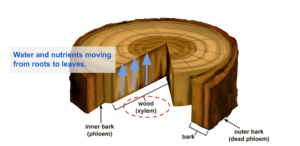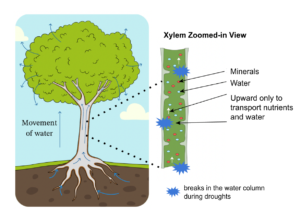This past summer, much of the New England region received less than half the usual amount of precipitation. Prolonged, repeated heat waves combined with very little rain caused crop losses and degraded ecosystems, including the urban forest. The impacts of the drought are visible right now with many trees losing their leaves earlier this fall or leaves browning out completely rather than changing color.
But how exactly does the drought affect a tree’s health?
Trees require water for evapotranspiration. Water moves up from the soil into their leaves, where it is used in photosynthesis. This also cools the leaf as the water evaporates, like sweat cools people. Without available water, the tree cannot do enough photosynthesis and produce enough energy to maintain its living tissues. This also weakens a tree’s ability to defend itself against insects and disease.
The amazing thing is that insects have evolved the ability to hear sounds made by drought-stressed trees. Using ultrasonic technology, scientists have captured the sound that a breaking water column makes inside of trees during water-stressed periods. These noises come from xylem, bunches of straw-like structures that form the wood inside tree trunks. Xylem transports water and nutrients from the soil to higher branches and leaves and can normally withstand high water pressure.
Water molecules are strongly attracted to each other, and normally the water column stays intact inside the xylem. When there’s less water available, the force required to move the water upwards increases, like when you have to suck harder on a straw to get the last drops of liquid from your glass. In severe drought conditions, this pressure can cause the water column to break. The dissolved oxygen in the water then reverts to gas and forms air bubbles in the xylem. These bubbles are called cavitations, and can damage the xylem so that it is no longer able to move water.
 Research has shown that insects can actually hear the sound of the water column breaking and use these noises to identify drought-stressed trees. These insects often introduce fungal spores to the interior of the tree, where the fungus can consume the tree. Normally a healthy tree can defend itself by growing a compartment around the fungus and isolate it from the rest of the tree. A drought stressed tree, however, won’t have adequate energy resources to do so.
Research has shown that insects can actually hear the sound of the water column breaking and use these noises to identify drought-stressed trees. These insects often introduce fungal spores to the interior of the tree, where the fungus can consume the tree. Normally a healthy tree can defend itself by growing a compartment around the fungus and isolate it from the rest of the tree. A drought stressed tree, however, won’t have adequate energy resources to do so.
Unfortunately, scientists have identified longer term ecological impacts of the drought as well. In our region, the groundwater levels are significantly low, and the soil moisture is so low that certain types of soil can become hydrophobic, actually repelling water rather than absorbing it.
Ecosystems take much longer than a few years to recover from the impacts of droughts. Scientists are concerned that this might be just the beginning of a series of severe events. New England already has one of the most variable climate systems among temperate zones around the globe. Going forward, the urban forest in Boston will need consistent watering and care as warming temperatures continue to make conditions less hospitable for trees.
To learn more about scientific facts of long-term drought effects on plants, visit https://ag.umass.edu/landscape/fact-sheets/long-term-drought-effects-on-trees-shrubs
This blog post was researched and written by Tiantian Zhu, MassCEC Intern. Stay tuned for an upcoming blog post and how we can help trees during droughts.
References:
https://www.wbur.org/news/2022/08/26/climate-change-flash-drought-massachusetts
https://www.cnn.com/2022/09/10/us/fall-colors-northeast-drought-climate/index.html
https://www.fs.usda.gov/rm/pubs_journals/2016/rmrs_2016_kolb_t002.pdf
